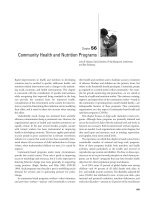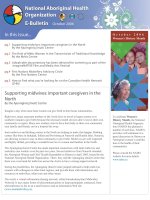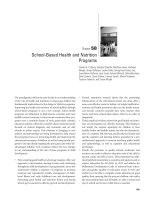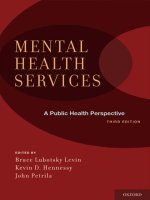Evaluating Community-based Health Professions Education Programs docx
Bạn đang xem bản rút gọn của tài liệu. Xem và tải ngay bản đầy đủ của tài liệu tại đây (123.52 KB, 13 trang )
PRACTICAL ADVICE
Evaluating Comm unity-based H ealth Professions
Education Programs
SUMMERS KALISHMAN, PhD
University of New Me xico School of Medi cine, Albuquerque, New
Mexico, USA
ABSTR ACT This paper assumes the reader (1) has little knowledge about progra m
e valuation, and (2) is interested in evaluation to improve a community-based health
profe ssions e ducation program. There are other important and useful approaches that c an
be used to address an evaluation of a community-based health professions education
program, and readers are encouraged to explore them—they appear in health education,
publ ic health education, in evaluation, and in program theory literature. The paper is
organized around a group of questions as a refe rence or organize r for the reader. These
inc lude topics like why evaluation is wanted, what kinds of questions can be addressed
through evaluation, who stakeholders are, who should conduct the evaluation, what
m ethods can be used, and how to analyze data and report results from the evaluation. In
the paper, I have attempted to include examples that are related to community-based
he alth professions programs. Finally, the paper ends with the recognition that there is
m uch more to learn in the eld of evaluation and s uggestions for ways to continue pursuit
of knowledge in this topical area.
Why Evaluate Community-based Health Professions Education
Programs?
Dani el Stufebeam has suggested that the ‘‘ purpose of evaluation is to
im prove, not to prove’’ and, in his model, promotes evaluation as a tool that
c an be used to assist programs to work better, and provide better services to the
program participants (1991). If this philosophy is applied in evaluation of
c ommunity-based health professions education program, a decisio n negotiated
A dd ress for correspondence: Summers Kalishman, PhD, Offic e of Program Evaluation,
Ed ucation and Research (PEAR), University of New Mexico School of Medicine, BMSB Room
B65G, Albuquerque, NM 87131, USA. Tel: +1-5 05-272-3998. Fax: +1-505-272 - 39 97.
E-m ail:
Ed ucation for Health, Vol. 15, No. 2, 2002, 228 – 240
E ducation for Health ISSN 1357–6283 print/ISSN 1469–5804 online
#
2002 Taylor & Francis Ltd
h ttp://www.tandf.co.uk/journals
DOI: 10.1080/1357628021013868 9
wi th stakeholders, the focus of the evaluation needs to be placed on what
enables programs to guid e them systematically towards that end.
Why Do Health Professions Education Programs Place Students in
Community- based Settings?
There are multiple reasons. Reasons include student exposure to precepted
learning, with patient care as the stimulus for clinical and/or basic science
k nowledge a nd skills gain (Oswald et al., 2001; Rosher et al., 2001),
opport unities for students to work with potential role models in communit y-
based settings (DeWitt et al., 2001), early multidisciplinar y clinical training
opport unities (Wartman et al., 2001), specic skills acquisition for learners
(W orley et al., 2000), service learning opportunities in which students provide
c linical service or health education service (Harris et al., 1998; Seifer, 1998), and
p opulation health research or collaborative community-based r esearch
ini tiative s (Fawc ett et al., 1999; Francisco et al., 1993). Other expectations for
learners involved in community-based health professions training programs are
f or them to initiate or become involved in community-based health projects, to
c ollaborate in their community-based education with students and faculty from
ot her disciplines, and to work on appropriate policy issues that address targeted
health issues with community groups (Kalishman et al., 1997; University of New
Mexico Health Sciences Center and the New Mexico Department of Health
Co mmunity Partnerships in Graduate Medical Nursing Education Grant,
1995).
Why Does a Community-based Health Professions Education
Program Want an Evaluation?
P rograms want and need to be able to tell thei r story in a way that is acceptable
t o the audience for whom the story is directed. Both subjective and objective
data help to tell the story. Well-managed programs recognize a need for
c ontinuous quality chec ks and feedback. Programmatic funding groups like
governm ent agencies or foundations require evaluations; in addition, uni-
versi ties or organizations that support educational programs of ten expect
int ernal oversight, need to report evidence to externa l accreditation agencies
and, therefore, require an evaluation. Programs want to tell their story. They
may als o recognize that they need to test their assumption s about the program’s
value and impact, and develop a means to improve the program through some
sort of systematic review. In addition, to sustain programs and the funding
required for them, programs often need to have and show evidence.
E valuating Education Programs 229
A Model of a Community-based Health Professions Education
Program
In this model, students enrolled at a university in medicine, nursing, physical
t herapy, occupational therapy, dentistry , dental hygiene, pharmacy, social work
or other health professions training are placed under the supervision of one or
mo re community-based preceptors for a specied period of time. Students
int eract with patients and client s with the guidance of their community-based
health professionals who are functioning in the community. In addition, the
stu dents interact with patients, provide clinical service to patients, and learn
basic, applied and holistic perspectives within this setting. Preceptors are
ex pected to teach and mentor students, trust the students to interact
appropriately in their professional workplace with patients and clients, and in
s ome programs may be expected to link students with other heal th
prof essionals in the community. At points in the interaction, preceptors are
asked to assess the students’ performance. In addition, some training programs
oc cur in community clinical settings and the board of the community clinic
pro vides oversight, reviews policies and procedures including university
t raining programs and precepted students in their clinic s. Some training
programs have established direct links with community boards or coalitions
wi th interest in promoting and improving the community healt h and well-being.
The community boards usually are non-prot entities and are circumscribe d by
geographic or political boundaries. In these community–campus arrangements,
stu dents participate in projects undertaken in the community with communit y
organizat ions or groups directed at community health improvement or policy
c hange. These projects may be new or ongoing projects undertaken by the
c ommunity organizations, or projects initiated by the students based on an
analysis of the needs and interest of the commun ity and its health priorities.
What Are Some of the Kinds of Questions that Can Be Asked of
These Kinds of Programs?
The following is a list that suggests a few questi ons that might be considered.
.
W hat happens to students in these settings? Are they learning? What are
t hey learning?
.
Is there an effect on the community when students are involved? What are
t he community groups, the health programs and health policies in which stu-
dents are involved? What are the benefits or the drawbacks of the program
and students’ involvement in the program?
.
W hat effect do these programs have on faculty who participate in them
(c ommunity-based preceptors and university-based preceptors)? What are
t he benefits or the drawbacks they experience?
230 S. Kalishman
.
W hat eff ect do these programs have on the institutions that are involved—
c ommunity clinics, university health science centers and their colleges, com-
m unity agencies and boards? What are the benefits or the drawbacks they
experience? What institutional policy changes have occurred to accommo-
date the program?
.
W hat evidence is needed to address program sustainability? What has to oc-
c ur to institutionalize the program? Are the institutions involved in the pro-
gram committed and/or willing to make the program a part of their regular
program? If not, what are the issues/concerns? Is ongoing funding available
t o support the program? What change s in policy are necessary in order to in-
st itutionalize the program? What evidence will demonstrate that a program
has been institutionalized?
.
W hat changes can be made in the program to improve the students’ learning
experience? How can the program better address the needs and improve the
benef its to faculty preceptors? What changes can be made to improve the
benef its and better meet the expectations of organizations, groups and com-
m unities involved in the program?
.
The process of decision-making and governance adopted by the entities par-
t icipating and implementing in the program may be an import ant issue to
evaluate. What process is used for decision-making about what issues? Is it
f ollowed? Is decision-making reviewed by other authorities, appealed, or
overturned? If so, by whom? Are members of the group satisfied with the
dec ision-making and governance process? Is decision-making effective,
t imely, and linked to sustainability of the collaborative? How does the pro-
c ess of decision-making and governance within the group relate to sustain-
abi lity of the program?
Resource Use
These questions may not apply to every program, but some of them will. There
i s an assumption that commu nity-based health professions education is
benecial to all the partners—the students, the faculty, the community and
t he institutions involved. Signicant resources are expended to enable these
programs to occur. Some of these resources are:
.
f undin g to house students in community settings,
.
t ransportation allowance for students,
.
st udents’ time and effort focused on community project and/or clinical learn -
i ng in a community,
.
reduc ed clinical revenues for commun ity-based faculty preceptors,
.
support for community preceptors based on program focus for computers,
f aculty development, or web-based clinical and teaching information,
E valuating Education Programs 231
.
c ommunity time and effort in orienting students to the community and work-
i ng with them in clinical, policy or health prom otion projects, and
.
prec eptors’ expertise and time for teaching and mentoring students.
Many of these programmatic questions are better answered than i gnored.
The plan to address these questions and the methods and direction undertaken
beco me the evaluation plan. The information from this type of an evaluation
c an help direct energy and resources toward maintaining and improving the
program. Usu ally, it is the program stakeholders who decide they need an
evaluation.
Who Are the Stakeholders?
In this example, the groups that have a vested interest in this program can be
c onsidered primar y stakeholders—the students, the faculty, deans and over-
sight group at th e university responsible for the program , and the community-
based preceptors. If there is a community clinic board, or a community
organizat ion or board involved, too, they are an equally important stakeholder.
These are the individuals and groups that need t o inform the evaluator and the
evaluation process. There are also secondary stakeholders, people or group s
wi th vested interests and with power, but who are more distant from the
p rogram. These individuals include representatives of licensing boards,
regulato ry groups , public ofcials , alumnae, special interest groups , and
c ommunity groups. In general, the interests of the second group are implicit,
a nd need to be considered, but they are seldom present i n regular
‘‘stakeholder’’ meetings.
Why Do the Stakeholders Want an Evaluatio n?
Is thi s a new or existing program? Is the evaluation needed to mee t external
requirements that come from a funding source that must be met to secure funds
or monitor the program? Are the stakeholders interested in information to hel p
secur e funding, or to answer questions that they and others have about the
program for which there is no syst ematic information? Do they see an
evaluation as an opportunity to develop or strengt hen connections between the
c ommunity and campus? Is this a program that has been around for sometime,
f or which only anecdotal evidence exists? Is the program under scrutiny for
ot her reasons and an evaluation may help to address nagging questions? Is the
program viewed as a model to be disseminated and ado pted by others? Is the
program being considered fo r expansion to other communities or for students
in other health professions programs?
232 S. Kalishman
As much as possible, asking the stakeholders to identify the reasons why
t here is a need for evaluation and what issues the particular evaluation will
address is an early, necessary step in evaluation planning. What does that look
li ke? Goals for the evaluation could include:
.
developm ent of an evaluation plan appropriate for this collaborative provid-
i ng community-based health professions education training;
.
sample from different methods of evaluation to find ones that work for t his
group;
.
developm ent of a system to document the impact of community-based health
prof essions education training on each of the organizations and communities
i nvolved; and
.
w riting about and sharing the findings as a step in dissemination of the pro-
gram.
Who Should Conduct the Evaluation? Internal and External
Evaluation Choices
The stakeholder group represents the constituencies involved in the program
and the leadership required for both the program and the evaluation to occur.
One of the rst questions stakeholders will face is who should conduct the
evaluation. There are tradeoffs in the answer given to this decision, and
stakehold ers should think about the delicate issues l ike the budget for
evaluation, access to data, data analysis and interpretation, and the need for
int ernal or external evaluation. Whoever is conducting the evaluation must
have the time t o do it, access to the stakeholders and to information about the
program, support and freedo m to contact all the levels of constituents, and
resourc es to conduct the evaluation.
Budgeting for evaluation involves the complexity of the questions under
stu dy but in general planning to appropriate 5 – 10% from the program budget
f or evaluation is reasonabl e place to begin. When multiple organizations are
wo rking together on a col laborative evaluation process, organizational issues
about data privacy, access t o data and freedom to review data may need to be
add ressed through a memorandum of understanding, submission of the
evaluation plan to an internal review board, or other processes. Internal
evalu ators are individuals or groups from within the organization. The
advantage of using them is usually greater accessibility between stakeholders
and evaluators (but not always), programmatic knowledge, and costs. Internal
evaluators may have some of their costs underwritten by the institutions or
organizat ions with whom they are employed, and may be less expensive. If you
are using an internal evaluator, it is important to ask a few questions. Is the
evaluator viewed as objective, without obvious bias or in any group’s control?
E valuating Education Programs 233
Do es the internal evaluator have freedom to discuss and present negative
ndings? If you cannot answer these questions to your satisfaction, you may
w ant to think about an external evaluator, someone from outside the
organizat ions with whom the group contracts for a speci c evaluation plan.
Ext ernal evaluations are usual ly more expensive, require clearl y identied
questi ons, and often are designed to respond to questions from the program
f unders. Stakeholders involved in them i nclude both local sites as well as
regional or national groups reviewing a demonstration project or initiative
t ogether. In thi s case, local stakeholders may not be involved in the decision
about the external evaluator or the evaluation plan that is selected, but may be
required to respond to those decisions.
Some programs use both internal and external evaluators. Usually, the
f unds for the external evaluation component are budgeted separately from the
evaluation for local programmatic and local evaluation support. Often, in these
arrangement s, both internal and external evaluations occur with the two groups
int eracting and supporting each other.
What Will the Role of the Stakeholders Be in the Evaluation?
In an evaluation in which the major purpose of the evaluation is to improve the
program, stakeholders need to participate in evaluation planning, learn about
evaluation ndings p romptly, have an opportunity to comment on interpreta-
t ion of ndings and offer alternative interpretations, and be involved.
S takeholders and evaluators can negotiate regular times to meet with
represent atives from the different stakeholder groups as part of the evaluation
plan. In these meetings, each group can educate the other, and stakeholders will
have time to learn more about both evaluation and specic feedback about
t heir programs. Evaluation education comes from the teachable moment.
St akeholders may want to know how to plan for and respond to programmatic
reportin g requirements for continued funding, or may wi sh to prepare a report
f or the dean. These are t he opportunities to tie the needs the stakeholders have
t o information about evaluation design, tools, or methods, and something
specic and requested.
What Are t he Methods that an Evaluation Can Use to Address
These Questions?: Evaluation Design and Methodology
Let’s assume that the evaluation will concentrate on the benets of the
c ommunity-based hea lth professions education program t o each of the
stakehold er groups for a single initiative funded locally. Some of the met hods
t hat can be used to obtain data include the following.
234 S. Kalishman
Interviews
C onversations between t he interviewer and a particip ant with pre-
det ermined questions and probes to obtain responses to understand and
provide explanation about the reasons underlying a participant’s perspec-
t ive can be used to begin the proces s of development of a questionnaire,
t o conrm or disconrm data from other sources like questionnaires, to
probe underlying explanations related to questionnaire information from
f orced choice responses, and to double check opinions held at earlie r
poi nts in time by participants. Strengths of these types of data are
explanation and insight as well as opportunity to capture unanticipated
inf ormation/results. The limitations of this approach is that it is extremely
t ime intensive and does not len d itself to quick data collection or data
analysis.
Questionnaires/Surveys
W ritten instruments with forced choice or short answer items can be used to
ask about knowledge, skills, behaviors, attitudes and or perspectives. The
strength of this format is ease of data collection, analysis and reporting.
Lim itations of this approach ma y be narrow insight and explanation.
Focus Groups
Groups of participants with a similar role in the program (students or
c ommunity members or faculty) participate in a structured discussion with a
f acilitator about some specic aspects of the program. Strengths of this type
of data are explanation and insight as well as opportunity to capture
unant icipated information/results. The limitations of this approach is that it
is extremely time intensive and does not lend itself t o quick dat a collection
or data analysis.
Participant Observation
This involves watching and listening to meetings, discussions, interactions in
planni ng, implementation and debrieng about the program. Checklists, tallies,
descript ive narratives, rating forms all are means of recording information
observed in a participant observation. Strengths of this type of data are
evaluator insight s and reection, opportunity to create rich textual descriptions,
and to capture unanticipated data. This approach can be time intensive both in
data collection and in data analysis and reporting.
Analysis of Documents and Products from the Program
One document review is to collect and review the content, the status, and the
pol icy impact of the community projects undertaken by community/faculty/and
stu dents in this program. Reviews of memorandum of understandi ngs among
organizat ions that reect governance agreements, shared understanding s are
anot her form of analysis of documents.
E valuating Education Programs 235
Secondary Data
In the example in Table 1, secondary data from each clinical site were ob tained
t o report the number of patients seen by students at the clinical sites. These
data are available based on reporting systems from the clinical sites and access
t o these data must be developed with care and permission (Table 1).
Analyzing the Data and Reporting Results
In developing the methods, include purposeful use of similar questions with
dif ferent groups. This allows comparison of the information collected from on e
group with another (students compared to community and to preceptors) and
t he possibility of making comparisons from one year to another (students
expe riences in 2001 with student experiences in 2002). In relating the
inf ormation about the program, provide the views from each constituency
group and point out agreement and disagreement among them.
When the data are available, negotiate the format for reporting it as well as
wh o will receive the reports with the stakeholders. Do the stakeholders prefer
graphs and bullet points, text or tables? Let the use and the audience who will
use the report help guide the format. Develop a framework with the
stakehold ers to guide the integration of the multiple components in the
evaluation report. Involve program stakeholders to the degree they are
int erested and available in the evaluation process including in data analysis and
in development of recommendations associated with the evaluation.
If possible, encourage use of evaluation information as programmatic
feedback to address a ny glaring problems, to reassure the program
stakehold ers, and to plan for continuous improvement. Report interim as well
as longer term ndings to stakeholders. This approach is useful for use of
inf ormation, and usually alerts program stakeholders to problems or issues that
need their attention. If there are negative ndings to report, be thoughtful in
c ommunicating them.
Recognize There Is More to Learn about Evaluation
Evaluat ion is a discipline and there are numerous books, art icles, graduate level
programs and conferences devoted to this subject. This article has skimmed the
surface of evaluation. Ther e are many wonderful books to read on the subject,
but for someone who is a novice, I recommend reading Michael Q. Patton’s
Utilization-focused evaluation (1997). In this book, Patton presents the
hist orical issues framing evaluation and alternative ways to focus evaluations,
and synthesizes the dimensions of the competing methodologies from which
research and evaluation are drawn. He provides examples of different tools that
c an be used to address different evaluation questions. He explores approaches
236 S. Kalishman
Table 1.
Example of methods used in a community-based health professions education evaluation
Methods by group:
Variable by year Students Faculty Community
Year 1 Year 1 Year 1 Year 1
Expectation and Interviews with Interviews with Interviews with
satisfaction with program participants and participants and community members
non-participants non-participants who worked with
Reasons for students and faculty
participation/non- Observations of Observations of
participation planning and planning and Observations of
implementation in implementation in planning and
Benefits/drawbacks local communities local communities implementation in
and with oversight and with oversight local communities
Description of and group group and with oversight
assessment of community- group
based projects in which Description and
they participated copies of Tracking
community-based questionnaire to
Skills (learned, projects community boards:
emphasized, applied) policy initiatives and
changes related to
Policy initiatives and community health
community health projects projects: process
undertaken, status
Sustainability and sustainability
Year 2 Year 2 Year 2 Year 2
Satisfaction with program Survey (developed Survey (developed Interviews with
and one’s participation from interview data: from interview data) community members
Continued
E valuating Education Programs 237
Table 1.
(Continued )
Methods by group:
Variable by year Students Faculty Community
attention to skills who worked with
Skills (learned, learned and skills Observations of students and faculty
emphasized, applied) applied) students interacting on projects
with community
Clinical benefits Observations of preceptors/boards Observations of
students interacting students interacting
Policy initiatives and with community Description of and with community
community health preceptors/boards assessment of preceptors/boards
projects community-based
Description of projects in which No. of hours and
Sustainability community-based they participated patients seen by
projects in which students in
students participated community-based
health settings
Assesment of
projects in which
community members
participated with
students
Tracking policy
initiatives and
changes related to
community health
projects
Continued
238 S. Kalishman
Table 1.
(Continued )
Methods by group:
Variable by year Students Faculty Community
Year 3 Year 3 Year 3 Year 3
Satisfaction with program Survey Survey Focus groups with
and one’s participation community-based
Description of Description of boards at sites where
Skills (learned, community-based and assessment of students worked
emphasized, applied) projects in which community-based
students projects in which Interviews with
Clinical benefits participated they participated who worked with
Policy initiatives and students and faculty
community health projects on projects
Sustainability No. of hours and
patients seen by
students in
community-based
health settings
Assessment of
projects in which
they participated with
students
Tracking policy
initiatives and
changes related to
community health
projects
E valuating Education Programs 239
t hat strengthen evaluations, and threats to ndings in a practical and user-
f riendly narrative. Finally, have fun! Being an evaluator or informing an
evaluation is a gift —learn and enjoy the process.
References
D
E
W
ITT
, D.E., M
IGEON
, M., L
E
B
LOND
, R., C
ARLINE
, J.D., F
RANCIS
, L. & I
RBY
, D.M.
(2001). Insights from outstanding rural internal medicine residency rotations at the
U niversity of Washington. Academic Medicine, 76(3) , 273 – 281.
F
AWCETT
, S.B., F
RANCISCO
, V.T., P
AINE
-A
NDREWS
, A. & S
CHULTZ
, J.A. (2000).
Working together for healthier comm unities: a research-based memorandum of
collaboration. Public Health Reports, 115(2-3), 174 – 179.
F
RANCISCO
, V.T., P
AINE
, A.L. & F
AWCETT
, S.B. (1993). A methodology for monitoring
and evaluating community health coalitions. Health Education Resear ch, 8, 403 – 416.
H
ARRIS
, D.L., S
TARAMAN
, S.M., H
ENRY
, R.C. & B
LAND
, C.J. (1998). Multidisciplinary
educ ation outcomes of the W.K. Kellogg community partnerships and health
professions education initiative. Academic Medicine, 73, S13 – S15.
K
ALISHMAN
, S., R
UMAN
, C., M
INES
, J. & S
ERNA
, L. (1997). 1996 – 1997 evaluation
repor t: New Mexico’s community health partnerships, WK Kellogg Foundation
funded initiative. Internal report, Albuquerque, NM.
O
SWALD
, N., A
LDERSON
, T. & J
ONES
, S. (2001). Evaluation primary care as a base for
m edical education: the report of the Cambridge community-based clinical course.
Me dical Education , 35, 782 – 788.
P
ATTON
, M.Q. (1997). Utilization-focused evaluation: the new century text, 3rd edn.
Thousand Oaks, CA: Sage.
R
OSHER
, R.B., R
OBINSON
, S.B., B
OESDORFER
, D. & L
EE
, K. (2001). Interdisciplinar y
educ ation in a community-based geriatric evaluation clinic. Teaching and Learning
in Medicine, 13, 247 – 252.
S
EIFER
, S.D. (1998). Service-learning: community – campus partnerships for health
professions education. Academic Medicine, 73, 273 – 277.
S
TUFFLEBEAM
, D. (1991). The C IPP model for program evaluation. In: G.F M
ADAUS
,
M. S
CRIVEN
& D.L. S
TUFFLEBEAM
(E ds), Evaluation models: viewpoints on
e ducational and human service s evaluation. Boston, MA: Kluwer – Nijhoff.
U
NIVERSITY OF
N
EW
M
EXICO
H
EALTH
S
CIENCES
C
ENTER AND THE
N
EW
M
EXICO
D
EPARTMENT OF
H
EALTH
C
OMMUNITY
P
ARTNERSHIPS IN
G
RADUATE
M
EDICAL
N
URSING
E
DUCATION
G
RANT
. (1995). Internal report to the W.K. Kellog g
Foundation, Albuquerque, NM.
W
ARTMAN
, S., D
AVIS
, A., W
ILSON
, M., K
AHN
, N., S
HERWOOD
, R. & N
OWALK
, A. (2001).
Curri cular change: recommendations from a national perspective. Academic
Me dicine, 76, S140 – S145.
W
ORLEY
, P., S
ILAGY
P
RIDEAUX
, D., N
EWBLE
, D. & J
ONES
, A. (2000). The parallel rural
c ommunity curriculum: an integrated curriculum based in rural general practice.
Me dical Education , 34, 558 – 565.
240 S. Kalishman









